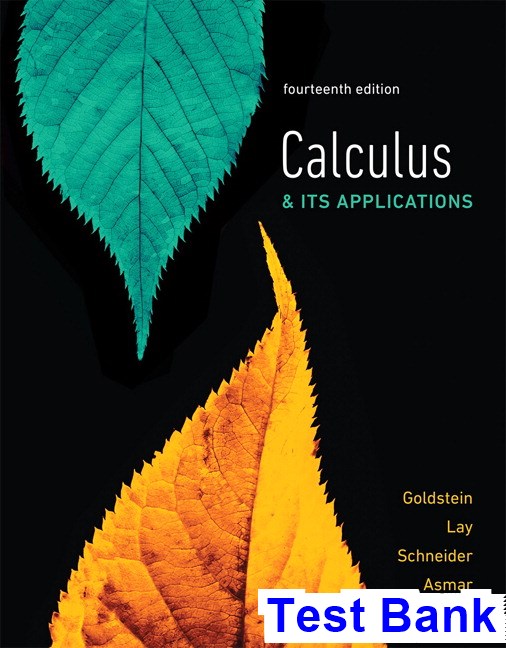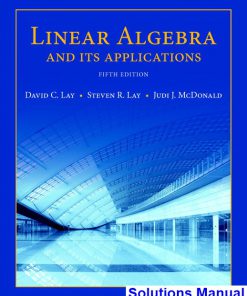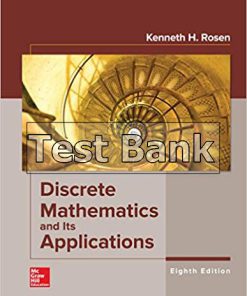Calculus and Its Applications 14th Edition Goldstein Test Bank
You may also like
This is completed downloadable of Calculus and Its Applications 14th Edition Goldstein Test Bank

Product Details:
- ISBN-10 : 0134437772
- ISBN-13 : 978-0134437774
- Author:
Calculus & Its Applications builds intuition with key concepts of calculus before the analytical material. For example, the authors explain the derivative geometrically before they present limits, and they introduce the definite integral intuitively via the notion of net change before they discuss Riemann sums. The strategic organization of topics makes it easy to adjust the level of theoretical material covered. The significant applications introduced early in the course serve to motivate students and make the mathematics more accessible. Another unique aspect of the text is its intuitive use of differential equations to model a variety of phenomena in Chapter 5, which addresses applications of exponential and logarithmic functions.
Table of Content:
- Chapter 0 Functions
- 0.1 Functions and Their Graphs
- Real Numbers
- Solution
- Solution
- Functions
- Solution
- Solution
- Solution
- More about the Domain of a Function
- Solution
- Graphs of Functions
- Solution
- Solution
- Solution
- Solution
- Check Your Understanding 0.1
- Exercises 0.1
- Technology Exercises
- Solutions to Check Your Understanding 0.1
- 0.2 Some Important Functions
- Linear Functions
- Solution
- Solution
- Solution
- Solution
- Piecewise-Defined Functions
- Solution
- Quadratic Functions
- Polynomial and Rational Functions
- Power Functions
- Absolute Value Functions
- Check Your Understanding 0.2
- Exercises 0.2
- Technology Exercises
- Solutions to Check Your Understanding 0.2
- 0.3 The Algebra of Functions
- Operations on Functions
- Solution
- Solution
- Solution
- Solution
- Composition of Functions
- Solution
- Solution
- Solution
- Check Your Understanding 0.3
- Exercises 0.3
- Technology Exercises
- Shifting a Graph
- Solutions to Check Your Understanding 0.3
- 0.4 Zeros of Functions—The Quadratic Formula and Factoring
- The Quadratic Formula
- Solution
- Solution
- Solution
- Factoring
- Solution
- Solution
- Solution
- Solution
- Solution
- Solution
- Check Your Understanding 0.4
- Exercises 0.4
- Technology Exercises
- Solutions to Check Your Understanding 0.4
- 0.5 Exponents and Power Functions
- Solution
- Compound Interest
- Solution
- Solution
- Solution
- Solution
- Solution
- Check Your Understanding 0.5
- Exercises 0.5
- Technology Exercises
- Solutions to Check Your Understanding 0.5
- 0.6 Functions and Graphs in Applications
- Geometric Problems
- Solution
- Business Problems
- Solution
- Solution
- Functions and Graphs
- Solution
- Solution
- Solution
- Check Your Understanding 0.6
- Exercises 0.6
- Technology Exercises
- Solutions to Check Your Understanding 0.6
- Chapter 0 Summary
- Chapter 0 Fundamental Concept Check Exercises
- Chapter 0 Review Exercises
- Chapter 1 The Derivative
- 1.1 The Slope of a Straight Line
- Fixed and Marginal Costs
- Solution
- Interpreting the Slope and y-Intercept
- Solution
- Depreciation of Equipment
- Solution
- Calculations Involving Slope of a Line
- Finding the Slope and y-Intercept
- Solution
- Sketching a Line Given a Point and a Slope
- Solution
- Slope of Line through Two Points
- Solution
- Equation of Line Given a Point and a Slope
- Solution
- Equation of Line through Two Points
- Solution
- Equation of Line Parallel to a Given Line
- Solution
- The Slope as a Rate of Change
- Temperature in a City
- Solution
- Check Your Understanding 1.1
- Exercises 1.1
- Technology Exercises
- Solutions to Check Your Understanding 1.1
- 1.2 The Slope of a Curve at a Point
- Slope of a Graph
- Solution
- Slope of a Graph as a Rate of Change
- Slope as a Rate of Change
- Solution
- Slope of a Graph
- Solution
- Slope Formulas
- Using a Slope Formula
- Solution
- Check Your Understanding 1.2
- Exercises 1.2
- Technology Exercises
- Solutions to Check Your Understanding 1.2
- 1.3 The Derivative and Limits
- Examples of Derivatives: The Power Rule
- Applying the Power Rule
- Solution
- Geometric Meaning of the Derivative and Equation of the Tangent Line
- Evaluating the Derivative at One Point
- Solution
- Finding an Equation of the Tangent Line at a Given Point
- Solution
- Finding the Equation of the Tangent Line at a Given x
- Solution
- Equation of the Tangent Line at a Given Point
- Solution
- Using the Derivative to Solve Tangent Problems
- Solution
- Notation
- Limits and the Secant-Line Calculation of the Derivative
- Verification of the Power Rule for r = 2
- Solution
- Check Your Understanding 1.3
- Exercises 1.3
- Technology Exercises
- Solutions to Check Your Understanding 1.3
- 1.4 Limits and the Derivative
- Computing a Limit Using a Table of Values
- Solution
- Computing Limits Using Graphs
- Solution
- Two Basic Limits
- Solution
- Using Properties of Limits
- Solution
- Factoring Techniques
- Solution
- Limit Definition of the Derivative
- Computing a Derivative from the Limit Definition
- Solution
- Computing Derivative from the Definition
- Solution
- Derivative of a Rational Function
- Solution
- Derivative of a Function with a Radical
- Solution
- 1.5 Differentiability and Continuity
- Hauling Cost
- Solution
- Manufacturing Cost
- Solution
- Continuity at a Point
- Solution
- Check Your Understanding 1.5
- Exercises 1.5
- Solutions to Check Your Understanding 1.5
- 1.6 Some Rules for Differentiation
- Appendix Proofs of the Constant-Multiple and Sum Rules
- 1.7 More about Derivatives
- Differentiating with Respect to a Specific Variable
- Solution
- The Derivative as a Rate of Change
- Declining Sales
- Solution
- The Marginal Concept in Economics
- Marginal Cost
- Solution
- Predicting Profits
- Solution
- Check Your Understanding 1.7
- Exercises 1.7
- Technology Exercises
- Solutions to Check Your Understanding 1.7
- 1.8 The Derivative as a Rate of Change
- Average Rates of Change
- Solution
- Comparing the Average and Instantaneous Rates
- Solution
- Rates of Change of a Population Model
- Solution
- Velocity and Acceleration
- Velocity and Average Velocities
- Solution
- Position, Velocity, and Acceleration
- Solution
- Approximating the Change in a Function
- Approximating a Production Function
- Solution
- Marginal Cost
- Solution
- Units for Rate of Change
- Check Your Understanding 1.8
- Exercises 1.8
- Technology Exercises
- Solutions to Check Your Understanding 1.8
- Chapter 1 Summary
- Chapter 1 Fundamental Concept Check Exercises
- Chapter 1 Review Exercises
- Chapter 2 Applications of the Derivative
- 2.1 Describing Graphs of Functions
- Extreme Points
- Solution
- Changing Slope
- Solution
- Concavity
- Solution
- Intercepts, Undefined Points, and Asymptotes
- Check Your Understanding 2.1
- Exercises 2.1
- Technology Exercises
- Solutions to Check Your Understanding 2.1
- 2.2 The First- and Second-Derivative Rules
- Solution
- Solution
- Connections between the Graphs of f(x) and f'(x)
- Solution
- Solution
- Check Your Understanding 2.2
- Exercises 2.2
- Technology Exercises
- Solutions to Check Your Understanding 2.2
- 2.3 The First- and Second-Derivative Tests and Curve Sketching
- Locating Relative Extreme Points
- Solution
- Solution
- Using Concavity to Determine Extreme Points
- Solution
- Solution
- Locating Inflection Points
- Solution
- Solution
- Check Your Understanding 2.3
- Exercises 2.3
- Technology Exercises
- Solutions to Check Your Understanding 2.3
- 2.4 Curve Sketching (Conclusion)
- Solution
- Solution
- Solution
- A Graph with Asymptotes
- Solution
- Summary of Curve-Sketching Techniques
- Check Your Understanding 2.4
- Exercises 2.4
- Technology Exercises
- Solutions to Check Your Understanding 2.4
- 2.5 Optimization Problems
- Solution
- Solution
- Solution
- Solution
- Solution
- Check Your Understanding 2.5
- Exercises 2.5
- Technology Exercises
- Solutions to Check Your Understanding 2.5
- 2.6 Further Optimization Problems
- Inventory Control
- Solution
- Solution
- Solution
- Solution
- Check Your Understanding 2.6
- Exercises 2.6
- Technology Exercises
- Solutions to Check Your Understanding 2.6
- 2.7 Applications of Derivatives to Business and Economics
- Cost Functions
- Solution
- Revenue Functions
- Solution
- Solution
- Profit Functions
- Solution
- Solution
- Setting Production Levels
- Check Your Understanding 2.7
- Exercises 2.7
- Solutions to Check Your Understanding 2.7
- Chapter 2 Summary
- Chapter 2 Fundamental Concept Check Exercises
- Chapter 2 Review Exercises
- Chapter 3 Techniques of Differentiation
- 3.1 The Product and Quotient Rules
- Verifying the Product Rule
- Solution
- Finding the Derivative of a Product
- Solution
- The Product Rule
- Solution
- Differentiating and Simplifying
- Solution
- The Quotient Rule
- Using the Quotient Rule
- Solution
- Simplifying after the Quotient Rule
- Solution
- Simplifying after the Quotient Rule
- Solution
- Appendix: Verification of the Product and Quotient Rules
- Verification of the Product Rule
- Verification of the Quotient Rule
- Check Your Understanding 3.1
- Exercises 3.1
- Technology Exercises
- Solutions to Check Your Understanding 3.1
- 3.2 The Chain Rule
- Composition of Functions
- Composition of Functions
- Solution
- Decomposing Composite Functions
- Solution
- Chain Rule
- The General Power Rule as a Chain Rule
- Solution
- Derivative of a Function That Is Not Specified
- Solution
- The Chain Rule
- Solution
- Marginal Revenue and Time Rate of Change
- Solution
- Time Rate of Change of Revenue
- Solution
- Appendix: Verification of the Chain Rule
- Check Your Understanding 3.2
- Exercises 3.2
- Solutions to Check Your Understanding 3.2
- 3.3 Implicit Differentiation and Related Rates
- Implicit Differentiation
- Finding the Slope Using Implicit Differentiation
- Solution
- Related Rates
- A Point Moving along a Graph
- Solution
- Check Your Understanding 3.3
- Exercises 3.3
- Solutions to Check Your Understanding 3.3
- Chapter 3 Summary
- Chapter 3 Fundamental Concept Check Exercises
- Chapter 3 Review Exercises
- Chapter 4 The Exponential and Natural Logarithm Functions
- 4.1 Exponential Functions
- Laws of Exponents
- Using the Laws of Exponents
- Solution
- Exponential Functions
- Solving Equations with Exponentials
- Solution
- Check Your Understanding 4.1
- Exercises 4.1
- Technology Exercises
- Solutions to Check Your Understanding 4.1
- 4.2 The Exponential Function ex
- Derivative of an Exponential Calculate
- Solution
- Applying the Laws of Exponents with ex
- Solution
- Tangent Line to an Exponential Graph
- Solution
- Derivatives Involving ex
- Solution
- Differentiating an Exponential
- Solution
- Graph of an Exponential
- Solution
- 4.3 Differentiation of Exponential Functions
- Derivative of Functions of the Form eg(x)
- Solution
- Quotient Rule with Exponential Functions
- Solution
- Combined Returns from Two Investments
- Solution
- Check Your Understanding 4.3
- Exercises 4.3
- Technology Exercises
- Solutions to Check Your Understanding 4.3
- 4.4 The Natural Logarithm Function
- Using Properties of Exponential and Logarithm Functions
- Solution
- Solving Equations with Exponentials
- Solution
- Solving Equations with Logarithms
- Solution
- Other Exponential and Logarithm Functions
- An Investment Portfolio
- Solution
- Check Your Understanding 4.4
- Exercises 4.4
- Technology Exercises
- Solutions to Check Your Understanding 4.4
- 4.5 The Derivative of ln X
- Derivatives Involving In x
- Solution
- Derivatives of Functions of the Form y=ln[g(x)]
- Solution
- Analyzing a Function Involving ln x
- Solution
- Derivative of ln |x|
- Solution
- Check Your Understanding 4.5
- Exercises 4.5
- Technology Exercises
- Solutions to Check Your Understanding 4.5
- 4.6 Properties of the Natural Logarithm Function
- Simplifying Expressions with Logarithms
- Solution
- Simplifying Expressions with Logarithms
- Solution
- Using Properties of the Logarithms
- Solution
- Differentiating after Simplifying
- Solution
- Logarithmic Differentiation
- Logarithmic Differentiation
- Solution
- Check Your Understanding 4.6
- Exercises 4.6
- Solutions to Check Your Understanding 4.6
- Chapter 4 Summary
- Chapter 4 Fundamental Concept Check Exercise
- Chapter 4 Review Exercises
- Chapter 5 Applications of the Exponential and Natural Logarithm Functions
- 5.1 Exponential Growth and Decay
- Exponential Growth
- Solving a Differential Equation
- Solution
- Exponential Growth of a Fruit Flies Population
- Solution
- A Differential Equation with Initial Condition
- Solution
- Exponential Growth
- Solution
- Determining the Growth Constant
- Solution
- Working with a Differential Equation
- Solution
- Exponential Decay
- Exponential Decay
- Solution
- Half-Life and Decay Constant
- Solution
- Radiocarbon Dating
- Carbon Dating
- Solution
- The Time Constant
- Check Your Understanding 5.1
- Exercises 5.1
- Solutions to Check Your Understanding 5.1
- 5.2 Compound Interest
- Continuous Compounding
- Continuous Compound Interest
- Solution
- Appreciation of a Painting
- Solution
- Ordinary Versus Continuous Compounding
- Negative Interest Rates
- Negative Interest Rate
- Solution
- Present Value
- Present Value
- Solution
- A Limit Formula for e
- Check Your Understanding 5.2
- Exercises 5.2
- Technology Exercises
- Solutions to Check Your Understanding 5.2
- 5.3 Applications of the Natural Logarithm Function to Economics
- Log Derivative and Relative Rate of Change
- Solution
- Gross Domestic Product
- Solution
- Constant Relative Rate of Change
- Solution
- Elasticity of Demand
- Elasticity of Demand
- Solution
- Elasticity, Price and Revenue
- Elasticity of Demand
- Solution
- Check Your Understanding 5.3
- Exercises 5.3
- Technology Exercises
- Solutions to Check Your Understanding 5.3
- 5.4 Further Exponential Models
- Terminal Velocity
- Velocity of a Skydiver
- Solution
- The Learning Curve
- Diffusion of Information by Mass Media
- Diffusion of Information
- Solution
- Intravenous Infusion of Glucose
- Logistic Growth
- Logistic Growth
- Solution
- An Epidemic Model
- Spread of an Epidemic
- Solution
- Check Your Understanding 5.4
- Exercises 5.4
- Technology Exercises
- Solutions to Check Your Understanding 5.4
- Chapter 5 Summary
- Chapter 5 Fundamental Concept Check Exercises
- Chapter 5 Review Exercises
- Chapter 6 The Definite Integral
- 6.1 Antidifferentiation
- Determining the Height of a Rocket from Its Velocity
- Solution (Part 1)
- A Power Function
- Solution
- An Exponential Function
- Solution
- 6.2 The Definite Integral and Net Change of a Function
- Computing a Definite Integral
- Solution
- Definite Integral of an Exponential
- Solution
- Properties of the Definite Integral
- The Definite Integral as a Net Change of a Function
- Net Change in Position
- Solution
- Marginal Revenue Analysis
- Solution
- Net Increase in Federal Health Expenditures
- Solution
- Check Your Understanding 6.2
- Exercises 6.2
- Solution to Check Your Understanding 6.2
- 6.3 The Definite Integral and Area under a Graph
- Verifying Theorem I
- Solution
- Area under the Graph of a Function
- Solution
- Area under a Cubic
- Solution
- Riemann Sums
- Approximating the Area of a Waterfront Lot
- Solution
- A Riemann Sum Approximation of an Area
- Solution
- Improving a Riemann Sum Approximation
- Solution
- Check Your Understanding 6.3
- Exercises 6.3
- Technology Exercises
- Solutions to Check Your Understanding 6.3
- 6.4 Areas in the xy-Plane
- Area Bounded by a Curve and the x-Axis
- Solution
- Area Bounded by a Curve and the x-Axis
- Solution
- Area between Two Curves
- Area between Two Curves
- Solution
- Area between Two Curves
- Solution
- Area between Two Curves
- Solution
- Area between Two Curves and Points of Intersection
- Solution
- Area between Two Curves and Points of Intersection
- Solution
- Areas in Applications
- Marginal Profit
- Solution
- Displacement versus Distance Traveled
- Solution
- Launch of an Online Transportation Network
- Solution
- Areas in the Theory of Calculus: The Area Function
- Check Your Understanding 6.4
- Exercises 6.4
- Technology Exercises
- Solutions to Check Your Understanding 6.4
- 6.5 Applications of the Definite Integral
- Using an Integral to Approximate a Sum
- Solution
- The Average Value of a Function
- Average Value
- Solution
- Average World Population
- Solution
- Consumers’ Surplus
- Consumers’ Surplus
- Solution
- Future Value of an Income Stream
- Future Value of an Income Stream
- Solution
- Solids of Revolution
- Volume of a Solid
- Solution
- Volume of a Cone
- Solution
- Check Your Understanding 6.5
- Exercises 6.5
- Technology Exercises
- Solutions to Check Your Understanding 6.5
- Chapter 6 Summary
- Chapter 6 Fundamental Concept Check Exercises
- Chapter 6 Review Exercises
- Chapter 7 Functions of Several Variables
- 7.1 Examples of Functions of Several Variables
- A Function with Two Variables
- Solution
- Application to Architectural Design
- Heat-Loss Function
- Solution
- Production Functions in Economics
- Production in a Firm
- Solution
- Level Curves
- Level Curves
- Solution
- Check Your Understanding 7.1
- Exercises 7.1
- Solutions to Check Your Understanding 7.1
- 7.2 Partial Derivatives
- Computing Partial Derivatives
- Solution
- Computing Partial Derivatives
- Solution
- Differentiation Rules and Partial Derivatives
- Solution
- Evaluating Partial Derivatives
- Solution
- Geometric Interpretation of Partial Derivatives
- Partial Derivatives and Rates of Change
- Interpreting Partial Derivatives
- Solution
- Partial Derivatives
- Solution
- Heat-Loss Function
- Solution
- Marginal Productivity of Capital
- Solution
- Partial Derivatives of Higher Order
- Partial Derivatives of Higher Order
- Solution
- Check Your Understanding 7.2
- Exercises 7.2
- Solutions to Check Your Understanding 7.2
- 7.3 Maxima and Minima of Functions of Several Variables
- First Derivative Test
- Locating a Minimum Point
- Solution
- Profit Function of Two Variables
- Solution
- Heat Loss
- Solution
- Second-Derivative Test
- Application of the Second-Derivative Test
- Solution
- Applying the Second-Derivative Test
- Solution
- Check Your Understanding 7.3
- Exercises 7.3
- Solutions to Check Your Understanding 7.3
- 7.4 Lagrange Multipliers and Constrained Optimization
- Problem
- Lagrange Multipliers
- Solution
- Lagrange Multipliers
- Solution
- Maximizing Production
- Solution
- Lagrange Multipliers in Three Variables
- Lagrange Multipliers in Three Variables
- Solution
- Check Your Understanding 7.4
- Exercises 7.4
- Solutions to Check Your Understanding 7.4
- 7.5 The Method of Least Squares
- Problem of Fitting a Straight Line to Data
- Problem
- Least-Squares Error
- Solution
- Car-Accident-Related Deaths in the U.S.
- Solution
- Check Your Understanding 7.5
- Exercises 7.5
- Solutions to Check Your Understanding 7.5
- 7.6 Double Integrals
- A Double Integral
- Solution
- A Double Integral
- Solution
- Volume Using a Double Integral
- Solution
- Double Integral over a Region
- Solution
- Check Your Understanding 7.6
- Exercises 7.6
- Solutions to Check Your Understanding 7.6
- Chapter 7 Summary
- Chapter 7 Fundamental Concept Check Exercises
- Chapter 7 Review Exercises
- Chapter 8 The Trigonometric Functions
- 8.1 Radian Measure of Angles
- Converting Degrees to Radians
- Solution
- Measuring Angles in Radians
- Solution
- Check Your Understanding 8.1
- Exercises 8.1
- Solutions to Check Your Understanding 8.1
- 8.2 The Sine and the Cosine
- Solving a Right Triangle
- Solution
- Values of the Cosine Function
- Solution
- Properties of the Sine and Cosine Functions
- Graphs of sin t and cos t
- Check Your Understanding 8.2
- Exercises 8.2
- Technology Exercises
- Solutions to Check Your Understanding 8.2
- 8.3 Differentiation and Integration of sin t and cos t
- Derivatives with the Sine Function
- Solution
- Derivatives with the Cosine Function
- Solution
- Differentiating Sine and Cosine Functions
- Solution
- Maximizing a Volume
- Solution
- Integrals of Sine Functions
- Solution
- Area under a Sine Curve
- Solution
- A Predators-and-Prey Model
- Solution
- Informal Justification of the Differentiation Rules for sin t and cos t
- Check Your Understanding 8.3
- Exercises 8.3
- Solutions to Check Your Understanding 8.3
- 8.4 The Tangent and Other Trigonometric Functions
- Determining the Height of a Building
- Solution
- The Derivative of tan t
- Derivatives of Tangent Functions
- Solution
- The Graph of tan t
- Check Your Understanding 8.4
- Exercises 8.4
- Solutions to Check Your Understanding 8.4
- Chapter 8 Summary
- Chapter 8 Fundamental Concept Check Exercises
- Chapter 8 Review Exercises
- Chapter 9 Techniques of Integration
- 9.1 Integration by Substitution
- Integration by Substitution
- First Solution
- Second Solution of Example 1
- Substitution with an Exponential
- Solution
- Substitution with a Radical
- Solution
- Substitution with a Logarithm
- Solution
- Substitution with an Exponential
- Solution
- Substitution with Fractional Powers
- Solution
- Integral of a Rational Function
- Solution
- Substitution with Trigonometric Functions
- Solution
- Check Your Understanding 9.1
- Exercises 9.1
- Solutions to Check Your Understanding 9.1
- 9.2 Integration by Parts
- Integration by Parts
- Solution
- Integration by Parts
- Solution
- Product of x and an Exponential Function
- Solution
- Product of x and a Trigonometric Function
- Solution
- Product of a Power of x and a Logarithm
- Solution
- Applying Integration by Parts Twice
- Solution
- A Logarithmic Function
- Solution
- Check Your Understanding 9.2
- Exercises 9.2
- Solutions to Check Your Understanding 9.2
- 9.3 Evaluation of Definite Integrals
- A Definite Integral with Substitution
- First Solution
- Second Solution
- Integration by Parts in Definite Integrals
- Definite Integral by Parts
- Solution
- Definite Integral by Parts
- Solution
- Check Your Understanding 9.3
- Exercises 9.3
- Solutions to Check Your Understanding 9.3
- 9.4 Approximation of Definite Integrals
- The Midpoint Rule
- Solution
- The Trapezoidal Rule
- Solution
- Measuring Cardiac Output
- Solution
- Distribution of IQs
- Solution
- Geometric Interpretation of the Approximation Rules
- Error Analysis
- Error Analysis
- Solution
- Check Your Understanding 9.4
- Exercises 9.4
- Technology Exercises
- Solutions to Check Your Understanding 9.4
- 9.5 Some Applications of the Integral
- Present Value of an Income Stream
- Solution
- Present Value of an Income Stream
- Solution
- A Demographic Model
- Solution
- Check Your Understanding 9.5
- Exercises 9.5
- Solutions to Check Your Understanding 9.5
- 9.6 Improper Integrals
- A Convergent Improper Integral
- Solution
- A Convergent Improper Integral
- Solution
- A Divergent Improper Integral
- Solution
- A Convergent Improper Integral
- Solution
- Check Your Understanding 9.6
- Exercises 9.6
- Solutions to Check Your Understanding 9.6
- Chapter 9 Summary
- Chapter 9 Fundamental Concept Check Exercises
- Chapter 9 Review Exercises
- Chapter 10 Differential Equations
- 10.1 Solutions of Differential Equations
- Verifying a Solution
- Solution
- Verifying a Solution
- Solution
- Initial Value Problems
- Solution
- Constant Solutions
- Solution
- Modeling with Differential Equations
- Newton’s Law of Cooling
- Solution
- Newton’s Law of Cooling
- Solution
- Geometric Meaning of a Differential Equation: Slope Fields
- Slope Field
- Solution
- Using a Slope Field to Analyze a Solution
- Solution
- Check Your Understanding 10.1
- Exercises 10.1
- Technology Exercises
- Solutions to Check Your Understanding 10.1
- 10.2 Separation of Variables
- Separation of Variables
- Solution
- Separation of Variables
- Solution
- Separation of Variables
- Solution
- Initial Value Problem
- Solution
- Initial Value Problem
- Solution
- Check Your Understanding 10.2
- Exercises 10.2
- Solutions to Check Your Understanding 10.2
- 10.3 First-Order Linear Differential Equations
- A First-Order Differential Equation
- Solution
- A First-Order Differential Equation
- Solution
- Initial-Value Problem
- Solution
- Check Your Understanding 10.3
- Exercises 10.3
- Technology Exercises
- Solutions to Check Your Understanding 10.3
- 10.4 Applications of First-Order Linear Differential Equations
- A Retirement Account
- Solution
- Paying Off a Car Loan
- Solution
- A Population Model with Emigration
- Solution
- Newton’s Law of Cooling
- Solution
- Newton’s Law of Cooling
- Solution
- Check Your Understanding 10.4
- Exercises 10.4
- Technology Exercises
- Solution to Check Your Understanding 10.5
- 10.5 Graphing Solutions of Differential Equations
- An Autonomous Differential Equation
- Solution
- Graphing a Solution
- Solution
- Constant Solutions and Graphing
- Solution
- Concavity of a Solution Curve
- Solution
- Check Your Understanding 10.5
- Exercises 10.5
- Technology Exercises
- Solutions to Check Your Understanding 10.5
- 10.6 Applications of Differential Equations
- Setting up a Differential Equation
- Solution
- Fish Population
- Solution
- Savings Account with Withdrawals
- Solution
- A One-Compartment Mixing Process
- Solution
- Check Your Understanding 10.6
- Exercises 10.6
- Solutions to Check Your Understanding 10.6
- 10.7 Numerical Solution of Differential Equations
- Euler’s Method
- Solution
- Check Your Understanding 10.7
- Exercises 10.7
- Technology Exercises
- Solutions to Check Your Understanding 10.7
- Chapter 10 Summary
- Chapter 10 Fundamental Concept Check Exercises
- Chapter 10 Review Exercises
- Chapter 11 Taylor Polynomials and Infinite Series
- 11.1 Taylor Polynomials
- A Polynomial Approximation
- Solution
- Taylor Polynomial Approximation of ex
- Solution
- A Taylor Polynomial Approximation
- Solution
- Using Taylor Polynomials to Approximate an Integral
- Solution
- Taylor Polynomials at x=a
- Centering a Taylor Polynomial
- Solution
- Accuracy of the Approximation
- Using the Remainder Formula
- Solution
- Check Your Understanding 11.1
- Exercises 11.1
- Technology Exercises
- Solution to Check Your Understanding 11.1
- 11.2 The Newton–Raphson Algorithm
- Approximation Using Newton–Raphson
- Solution
- Iterating the Newton–Raphson Algorithm
- Solution
- Approximating Zeros of a Polynomial
- Solution
- Approximating Solutions
- Solution
- Internal Rate of Return
- Solution
- Monthly Interest Rate of a Loan
- Solution
- Check Your Understanding 11.2
- Exercises 11.2
- Technology Exercises
- Solutions to Check Your Understanding 11.2
- 11.3 Infinite Series
- Geometric Series
- Solution
- A Rational Number as a Geometric Series
- Solution
- The Multiplier Effect in Economics
- Solution
- Elimination of a Drug
- Solution
- Sigma Notation
- Geometric Series and Sigma Notation
- Solution
- Check Your Understanding 11.3
- Exercises 11.3
- Technology Exercises
- Solutions to Check Your Understanding 11.3
- 11.4 Series with Positive Terms
- Applying the Integral Test
- Solution
- Applying the Integral Test
- Solution
- A Comparison Test
- Solution
- Check Your Understanding 11.4
- Exercises 11.4
- Solutions to Check Your Understanding 11.4
- 11.5 Taylor Series
- A Taylor Series Centered at 0
- Solution
- A Taylor Series Centered at 0
- Solution
- Operations on Taylor Series
- Differentiation and Integration Term by Term
- Solution
- Evaluating a Taylor Series
- Solution
- New Taylor Series from Known Ones
- Solution
- New Taylor Series from Known Ones
- Solution
- Definite Integrals
- Integration Term by Term
- Solution
- Convergence of Power Series
- Taylor Series at x=a
- Check Your Understanding 11.5
- Exercises 11.5
- Solutions to Check Your Understanding 11.5
- Chapter 11 Summary
- Chapter 11 Fundamental Concept Check Exercises
- Chapter 11 Review Exercises
- Chapter 12 Probability and Calculus
- 12.1 Discrete Random Variables
- Expected Value and Variance
- Solution
- Expected Value and Variance
- Solution
- Decision Making Based on Expected Value
- Solution
- Check Your Understanding 12.1
- Exercises 12.1
- Solutions to Check Your Understanding 12.1
- 12.2 Continuous Random Variables
- Probability Density
- Solution
- Determining a Probability Density
- Solution
- A Beta Probability Density
- Solution
- Age of a Cell
- Solution
- Random Selection
- Solution
- Working with a Probability Density
- Solution
- Check Your Understanding 12.2
- Exercises 12.2
- Solutions to Check Your Understanding 12.2
- 12.3 Expected Value and Variance
- Cumulative Distribution, Expected Value, and Variance
- Solution
- Average Age of a Cell Population
- Solution
- Random Selection in a Circle
- Solution
- Proportion of Students Using a Library
- Solution
- Check Your Understanding 12.3
- Exercises 12.3
- Solutions to Check Your Understanding 12.3
- 12.4 Exponential and Normal Random Variables
- Exponential Density Functions
- Exponential Density
- Solution
- Time between Phone Calls
- Solution
- Normal Density Functions
- A Standard Normal Random Variable
- Solution
- Length of a Metal Flange
- Solution
- Check Your Understanding 12.4
- Exercises 12.4
- Technology Exercises
- Solutions to Check Your Understanding 12.4
- 12.5 Poisson and Geometric Random Variables
- Poisson Random Variables
- A Poisson Distribution
- Solution
- Computing Probabilities with a Poisson Distribution
- Solution
- Modeling with a Poisson Distribution
- Solution
- Geometric Random Variables
- A Geometric Distribution in Quality Control
- Solution
- Expected Number of Defective Toys
- Solution
- Check Your Understanding 12.5
- Exercises 12.5
- Technology Exercises
- Solutions to Check Your Understanding 12.5
- Chapter 12 Summary
- Chapter 12 Fundamental Concept Check Exercises
- Chapter 12 Review Exercises
- Appendix Areas under the Standard Normal Curve
- Learning Objectives
- Chapter 0: Functions
- 0.1 Functions and Their Graphs
- 0.2 Some Important Functions
- 0.3 The Algebra of Functions
- 0.4 Zeros of Functions—The Quadratic Formula and Factoring
- 0.5 Exponents and Power Functions
- 0.6 Functions and Graphs in Applications
- Chapter 1: The Derivative
- 1.1 The Slope of a Straight Line
- 1.2 The Slope of a Curve at a Point
- 1.3 The Derivative and Limits
- 1.4 Limits and the Derivative
- 1.5 Differentiability and Continuity
- 1.6 Some Rules for Differentiation
- 1.7 More about Derivatives
- 1.8 The Derivative as a Rate of Change
- Chapter 2: Applications of the Derivative
- 2.1 Describing Graphs of Functions
- 2.2 The First- and Second-Derivative Rules
- 2.3 The First- and Second-Derivative Tests and Curve Sketching
- 2.4 Curve Sketching (Conclusion)
- 2.5 Optimization Problems
- 2.6 Further Optimization Problems
- 2.7 Applications of Derivatives to Business and Economics
- Chapter 3: Techniques of Differentiation
- 3.1 The Product and Quotient Rules
- 3.2 The Chain Rule and the General Power Rule
- 3.3 Implicit Differentiation and Related Rates
- Chapter 4: The Exponential and Natural Logarithm Functions
- 4.1 Exponential Functions
- 4.2 The Exponential Function ex
- 4.3 Differentiation of Exponential Functions
- 4.4 The Natural Logarithm Function
- 4.5 The Derivative of ln x
- 4.6 Properties of the Natural Logarithm Function
- Chapter 5: Applications of the Exponential and Natural Logarithm Functions
- 5.1 Exponential Growth and Decay
- 5.2 Compound Interest
- 5.3 Applications of the Natural Logarithm Function to Economics
- 5.4 Further Exponential Models
- Chapter 6: The Definite Integral
- 6.1 Antidifferentiation
- 6.2 The Definite Integral and Net Change of a Function
- 6.3 The Definite Integral and Area under a Graph
- 6.4 Areas in the xy–Plane
- 6.5 Applications of the Definite Integral
- Chapter 7: Functions of Several Variables
- 7.1 Examples of Functions of Several Variables
- 7.2 Partial Derivatives
- 7.3 Maxima and Minima of Functions of Several Variables
- 7.4 Lagrange Multipliers and Constrained Optimization
- 7.5 The Method of Least Squares
- 7.6 Double Integrals
- Chapter 8: The Trigonometric Functions
- 8.1 Radian Measure of Angles
- 8.2 The Sine and the Cosine
- 8.3 Differentiation and Integration of sin t and cos t
- 8.4 The Tangent and Other Trigonometric Functions
- Chapter 9: Techniques of Integration
- 9.1 Integration by Substitution
- 9.2 Integration by Parts
- 9.3 Evaluation of Definite Integrals
- 9.4 Approximation of Definite Integrals
- 9.5 Some Applications of the Integral
- 9.6 Improper Integrals
- Chapter 10: Differential Equations
- 10.1 Solutions of Differential Equations
- 10.2 Separation of Variables
- 10.3 First-Order Linear Differential Equations
- 10.4 Applications of First-Order Linear Differential Equations
- 10.5 Graphing Solutions of Differential Equations
- 10.6 Applications of Differential Equations
- 10.7 Numerical Solution of Differential Equations
- Chapter 11: Taylor Polynomials and Infinite Series
- 11.1 Taylor Polynomials
- 11.2 The Newton–Raphson Algorithm
- 11.3 Infinite Series
- 11.4 Series with Positive Terms
- 11.5 Taylor Series
- Chapter 12: Probability and Calculus
- 12.1 Discrete Random Variables
- 12.2 Continuous Random Variables
- 12.3 Expected Value and Variance
- 12.4 Exponential and Normal Random Variables
- 12.5 Poisson and Geometric Random Variables
- Sources
- Selected Answers
- Prerequisite Skills Diagnostic Test
- Exercises 0.1, page 9
- Exercises 0.2, page 18
- Exercises 0.3, page 23
- Exercises 0.4, page 31
- Exercises 0.5, page 39
- Exercises 0.6, page 47
- Chapter 0: Chapter Review Exercises, page 54
- Chapter 1
- Exercises 1.1, page 63
- Exercises 1.2, page 69
- Exercises 1.3, page 79
- Exercises 1.4, page 89
- Exercises 1.5, page 96
- Exercises 1.6, page 102
- Exercises 1.7, page 110
- Exercises 1.8, page 119
- Chapter 1 : Review Exercises, page 129
- Chapter 2
- Exercises 2.1, page 138
- Exercises 2.2, page 145
- Exercises 2.3, page 156
- Exercises 2.4, page 162
- Exercises 2.5, page 168
- Exercises 2.6, page 175
- Exercises 2.7, page 183
- Chapter 2: Chapter Review Exercises, page 190
- Chapter 3
- Exercises 3.1, page 199
- Exercises 3.2, page 206
- Exercises 3.3, page 215
- Chapter 3: Review Exercises, page 219
- Chapter 4
- Exercises 4.1, page 225
- Exercises 4.2, page 231
- Exercises 4.3, page 235
- Exercises 4.4, page 240
- Exercises 4.5, page 244
- Exercises 4.6, page 248
- Chapter 4 : Review Exercises, page 252
- Chapter 5
- Exercises 5.1, page 262
- Exercises 5.2, page 269
- Exercises 5.3, page 277
- Exercises 5.4, page 286
- Chapter 5: Review Exercises, page 289
- Chapter 6
- Exercises 6.1, page 299
- Exercises 6.2, page 307
- Exercises 6.3, page 317
- Exercises 6.4, page 329
- Exercises 6.5, page 338
- Chapter 6: Review Exercises, page 344
- Chapter 7
- Exercises 7.1, page 352
- Exercises 7.2, page 361
- Exercises 7.3, page 368
- Exercises 7.4, page 376
- Exercises 7.5, page 383
- Exercises 7.6, page 388
- Chapter 7: Review Exercises, page 392
- Chapter 8
- Exercises 8.1, page 397
- Exercises 8.2, page 402
- Exercises 8.3, page 409
- Exercises 8.4, page 414
- Chapter 8: Review Exercises, page 418
- Chapter 9
- Exercises 9.1, page 426
- Exercises 9.2, page 430
- Exercises 9.3, page 434
- Exercises 9.4, page 441
- Exercises 9.5, page 448
- Exercises 9.6, page 452
- Chapter 9: Review Exercises, page 459
- Chapter 10
- Exercises 10.1, page 466
- Exercises 10.2, page 473
- Exercises 10.3, page 478
- Exercises 10.4, page 483
- Exercises 10.5, page 492
- Exercises 10.6, page 498
- Exercises 10.7, page 504
- Chapter 10: Review Exercises, page 510
- Chapter 11
- Exercises 11.1, page 518
- Exercises 11.2, page 524
- Exercises 11.3, page 532
- Exercises 11.4, page 538
- Exercises 11.5, page 545
- Chapter 11: Review Exercises, page 549
- Chapter 12
- Exercises 12.1, page 557
- Exercises 12.2, page 564
- Exercises 12.3, page 569
- Exercises 12.4, page 577
- Exercises 12.5, page 584
- Chapter 12: Review Exercises, page 588
- Index of Applications
- Business and Economics
- Health and Life Sciences
- Physical Science
- Social Sciences
- General Interest
- Index
- A
- B
- C
- D
- E
- F
- G
- H
- I
- J
- L
- M
- N
- O
- P
- Q
- R
- S
- T
- U
- V
- W
- X
- Y
- Z
- Useful Algebraic Facts
- Useful Geometric Formulas
- Useful Differentiation Facts
- Useful Integration Facts
- MyMathLab®: Support You Need, When You Need It
- Review Prerequisite Skills
- Tutorial Videos
- Interactive Figures
People Also Search:
calculus and its applications goldstein
calculus and its applications 14th edition goldstein
calculus and its applications 14th edition
calculus and its applications 14th edition download scribd
calculus and its applications 14th edition testbank download pdf












